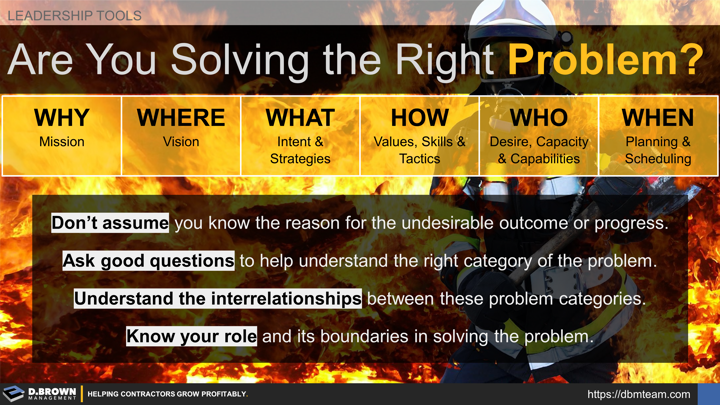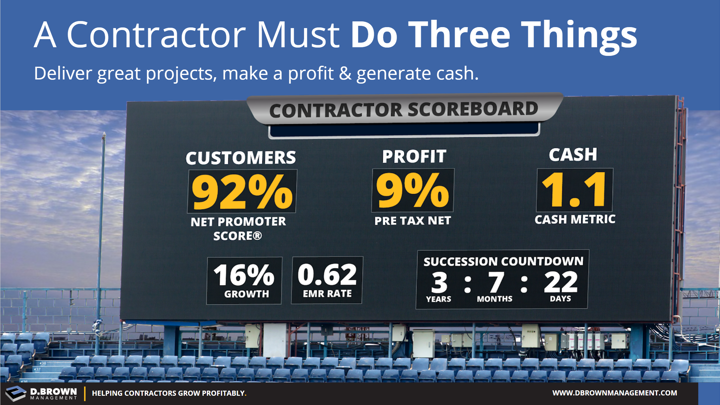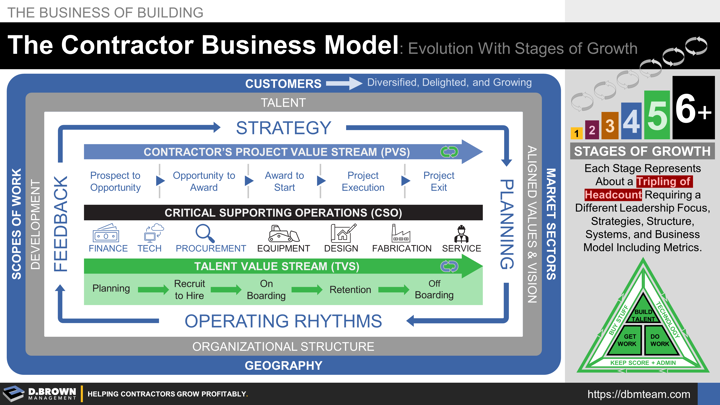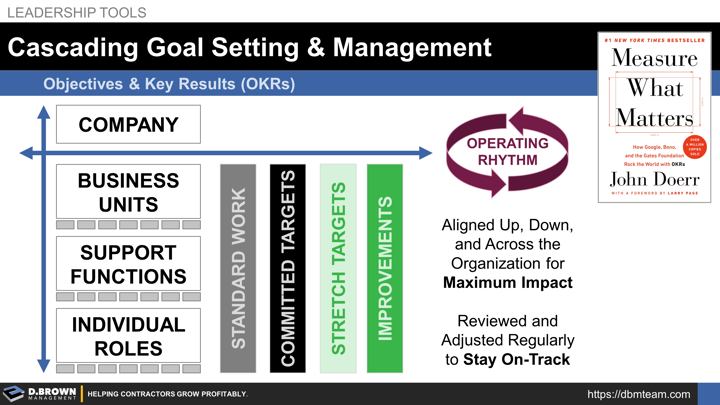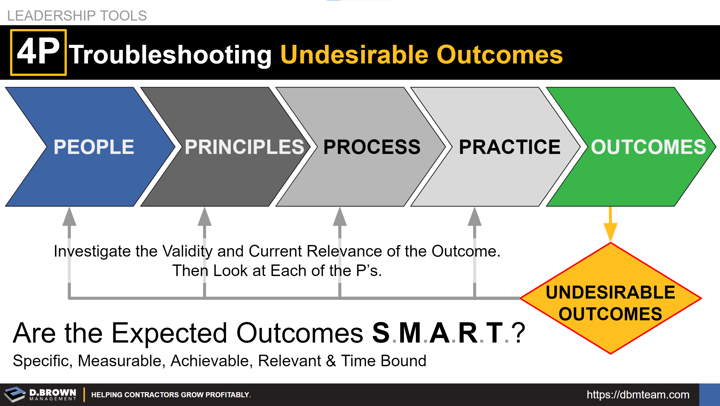Are we having a why, where, what, how, who or when problem?
Leading a construction business involves a lot of effective and prioritized problem solving.
The first thing you are looking for is ensuring that you aren't being limited by one of the three major constraints to sustained profitable growth:
- Available MARKET (Getting Work)
- Available CAPITAL (Financing the Work)
- Available LABOR (Doing the Work)
The next thing to take a look at is whether any of your high-level contractor scoreboard metrics could use the most improvement, including:
- Delighted Customers - Net Promoter Score(R) and repeat business
- Net Profits from Operations
- Cash Flow from Operations
- Growth Rate
- Safety Metric (EMR)
- Succession Countdown at All Levels - aligned with growth rate
Now start to dive into the details of your overall value-stream in a simplified model of your business, looking for the biggest bottleneck.
Ensuring that you have worked through this process recently will give you a good idea of what your top 3-5 biggest problems are and what your #1 problem to solve really is. That will at least give you an idea of whether the problem you are diagnosing is even on your top list. Many problems are simply not worth the time investment required to solve them at this time. Lots of time gets wasted by failing to prioritize and spending too much leadership time on problems that don't move the needle. If you do a great job of prioritizing, relentlessly solving your biggest bottlenecks, and building both into an organizational capability, then within years, your biggest problems will be very small details.
Now that you know whether the problem should even be solved at this time and what level of resources should be invested in solving, you can move to the next step of diagnosing.
Start with clarity of the outcome expected:
- Is the outcome measurable?
- How far off target are we, including schedule?
- What is the trend if applicable? Are we getting better or worse?
- Does everyone involved have good visibility on the outcome metrics?
Lots of effort gets wasted on people talking about feelings around the process or outcomes rather than actual information about the outcomes over time. If the outcomes aren't clear, then spend the appropriate amount of time clearly defining the outcomes required, whether a general company goal or part of a job role expectation and description.
Continue asking questions to determine what the category of the problem really is:
- Why - is there lack of clarity and alignment around why we are doing what we are doing, including how it fits into the bigger picture? Start with Why (Simon Sinek)
- Where - is there lack of clarity around where we are ultimately going and what that future state looks like?
- What - is there lack of clarity around the strategies to get there, including their intent?
- How - is there a lack of understanding about the specific tactics, tools, and skills to achieve those strategies, including the behavioral boundaries set by the organization's values?
- Who - are we lacking the resources as part of the problem solving team, or even within the organization, who have the desire, capabilities, and capacity to get this done?
- When - are we having a problem aligning resource (who) capacity and expectations as far as completion timing goes?
Those are six different basic levels of solving the problem. A lot of time can be wasted if good questioning and facilitation doesn't lead the team to the right level. Some examples include:
- A team deeply understands the why, where, and what. They also understand where they are at objectively against the expected outcomes. They are having a planning meeting focused on how, who, and by when. Most of their problem is simply a lack of resources (who) at the right level. A leader walks in and sees the missed outcome and participates in the meeting by reiterating the why, where, and what, over and over, assuming the reason for the missed outcomes is people now knowing what needs to be done. Team leaves demoralized and traction is lost.
- A team does not fully understand the why, where, and what. They are actively engaged in solving the how, who, and when based on their misinterpretation. A leader walks in and listens in on the discussions for a few minutes before they start providing corrective feedback on the how, who, and when, but without the common understanding of the why, where, and what, the team feels like they are at odds with their leader. Team doesn't understand the disconnect and leaves demoralized. Leader is frustrated with the team. Traction is lost.
Both these situations repeat themselves over and over in organizations, causing massive loss of traction and team engagement and leading to excessive stress, poor results, and increased turnover. Some closing food for thought on effective problem solving:
- Be very specific about the definition of the problem.
- Clarify both the desired outcome, actual outcome, problem statement, and progress in writing.
- If the problem is truly a priority, then invest whatever resources are necessary to solve it.
- Understand the four basic elements of Commander's Intent and know whether you are in the role of of leader or subordinate leader in each interaction.
- Practice asking really good questions to assess the level of the problem and whether the problem should even be prioritized to solve before jumping in to solve.
- Know that problem identification is incredibly easy.
- Recognize the difference between a bad outcome and a bad process.
- If you believe you have isolated the problem down to a who question and you believe they have both the desire and the capacity, then troubleshoot further using the 4Ps - People >> Principles >> Process >> Practice.

